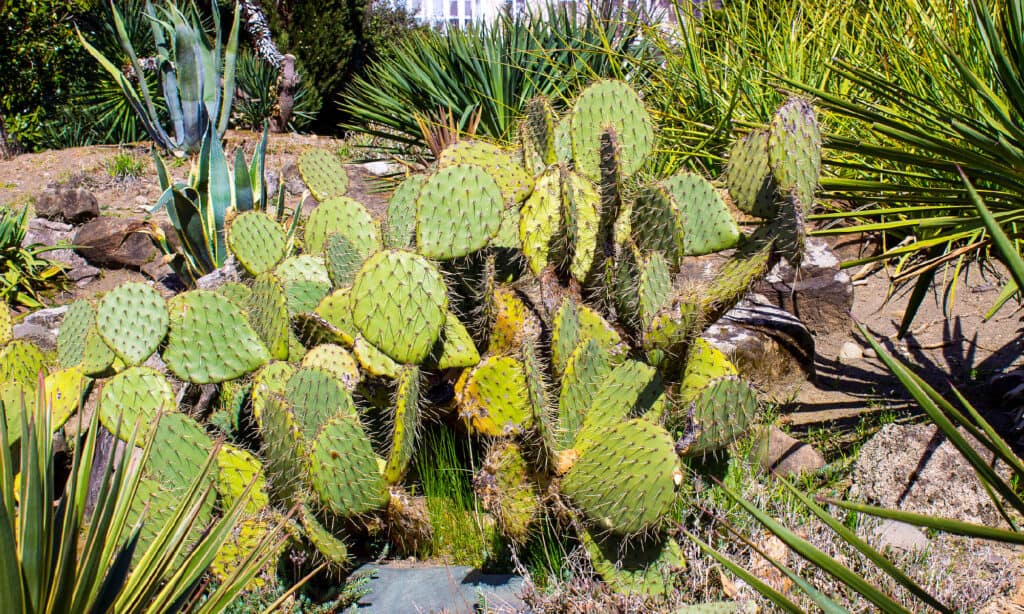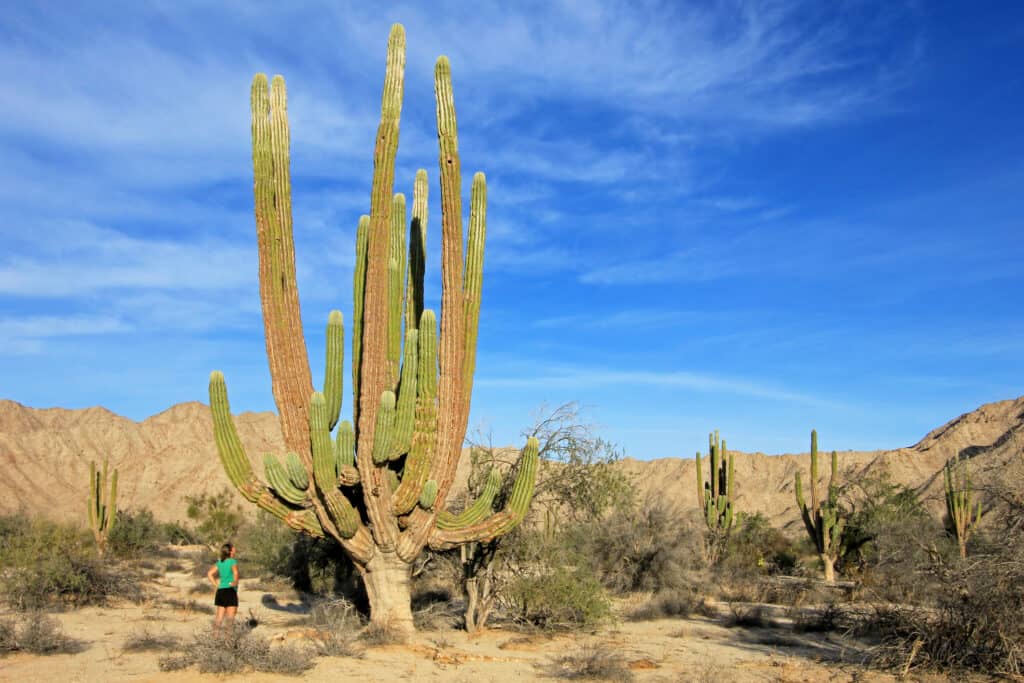When most people think of extremely large plants, what usually comes to mind is trees. After all, there are so many incredibly imposing trees, such as redwoods and giant sequoias. However, these are not the only large plants out there.
Cacti can also be very large. Of course, there are the tiny ones that you can grow in a little flowerpot indoors, but there are species of cacti that can be surprisingly huge when they are full-grown.
Of these cactus species, which one is the biggest? Read on to discover the largest cactus in the world!
What Is a Cactus?

Cacti are flowering plants known for their adaptations that keep them hydrated, including their famous spines.
©iStock.com/Marina Krisenko
Cacti are members of the family Cactaceae. This family includes a variety of species of flowering plants that have succulent stems. Even though not every cactus produces visible flowers, they do have the capability to bloom every year and produce many flowers when exposed to a lot of water.
Even though some people think of cacti as plants that strictly grow in the desert, many species can grow in a variety of habitats. They have many adaptations which allow them to fare better in dry environments than most plants, but this doesn’t always mean that they can only fare well in these dry environments.
Cacti have areoles, which distinguish them from other plants. These structures give rise to spikes, flowers, and new branches on the plant. These plants are covered with a cuticle, which is a waxy substance that allows them to retain their water.
Another way these plants conserve water is by only opening their stomata at night rather than during the day, as most plants do. Stomata are microscopic pores on the surface of the plant that allow carbon dioxide to enter for the plant to carry out photosynthesis.
The Spines of a Cactus
Perhaps the most distinguishing feature of all cacti is the prickly spines. Some cacti have soft, feathery spines, while others have ones that are hard and sharp.
Scientists believe that these are actually modified leaves. It’s possible that a very long time ago, cacti had leaves like the ones you would see on most trees and bushes now. But over time, it appears that those leaves evolved into the spikes that we now see on cacti. These spikes serve multiple purposes.
First, they help the cacti survive in the hot, dry environments that they usually inhabit. As the sun moves through the sky, the spikes on the cactus are casting shadows all over the body of the plant.
The spikes also serve as a defense mechanism to discourage animals from trying to eat the cactus. Since cacti are likely one of the few available sources of water in their dry environments, animals might otherwise try to access the water by causing damage to the cactus.
Additionally, the spines allow the cacti to obtain the water they need for survival. Usually, even though these plants grow in dry, arid environments, there are bodies of water nearby. Fog comes off of the water, and the spines create an area where the water can condense. The water eventually runs down the spine and body of the plant, going towards the roots.
The Largest Cactus in the World

Although the largest cactus species is the Mexican giant cardon, the largest ever cactus was a 78-foot-tall saguaro cactus.
©high fliers/Shutterstock.com
The largest cactus species in the world is the Mexican giant cardon (Pachycereus pringlei). Also known as the elephant cactus, this cactus typically reaches 20 to 30 feet in height when it’s fully grown.
However, there was one specimen that grew to be 63 feet (19.2 meters) tall, with a trunk that was 3.3 feet (1 meter) in diameter. But was this truly the largest cactus in the world?
In terms of overall appearance, the Mexican giant cardon is quite similar to the saguaro (Carnegiea gigantea), which is also a giant cactus. The saguaro will normally grow to be about 40 feet (12.2 meters) tall.
However, the tallest saguaro cactus that was ever measured – in fact, the tallest cactus that has ever been measured – was more than 78 feet tall! This cactus didn’t have arms, and it ended up blowing over in a windstorm in 1986.
Essentially, although the Mexican giant cardon is taller than the saguaro as a species, the tallest cactus ever was a Saguaro cactus.
Growth of the Largest Cactus in the World

The Mexican giant cardon grows very slowly, adding a few inches at most each year; it lives to be hundreds of years old.
©iStock.com/reisegraf
Whether we are talking about the Mexican giant cardon or the saguaro cactus, both grow very slowly.
Sometimes, it takes a whole decade for saguaro cacti to reach one inch (2.5 centimeters) in height. All growth takes place at the very top of the cactus. When they are 70 years old, they can be about 6.5 feet tall, and they can start to flower for the first time.
When they are about 100 years old, they can be 15 to 16 feet (4.6 to 4.9 meters) tall and start to produce their first arms. By the time they are 200 years old, they have generally reached their full height.
The Mexican giant cardon also grows very slowly, with the mean growth rate being 3.9 inches (9.8 centimeters) per year. These cacti can live to be up to 300 years old.
Animals That Interact with the Largest Cactus in the World

The saguaro cactus has many interactions with animals that pollinate its flowers, use it for nesting, and eat its flesh.
©iStock.com/Nate Hovee
Both the Mexican giant cardon and the saguaro cactus play active roles in their ecosystems. Many animals use these cacti for various purposes.
A study done on Mexican giant cardons of the Sonoran Desert found that at least 61 species of animals interact with this cactus. Bats eat the flowers that bloom on these cacti during the flowering season, and then they transfer the pollen. These cacti are usually pollinated by insects and birds. It also provides a home for many birds, such as the hawk.
There are also many birds who make their homes inside the flesh of the saguaro cactus. Gila woodpeckers and gilded flickers excavate nest cavities in this cactus, and when they abandon a cavity, other birds, such as sparrows, finches, purple martins, elf owls, and screech owls, might move in.
Larger birds, such as red-tailed hawks and Harris hawks, sometimes construct nests on the arms of large Saguaro cacti. Sometimes, great horned owls and ravens take over these hawks’ nests once abandoned.
These cacti also provide pollen and nectar for bats, which pollinate the flowers in turn. There are also many animals who will eat the flesh of this cactus for hydration when there is a scarcity of water, including pack rats, mule deer, bighorn sheep, and jackrabbits.
The photo featured at the top of this post is © Nate Hovee/Shutterstock.com
Thank you for reading! Have some feedback for us? Contact the AZ Animals editorial team.






